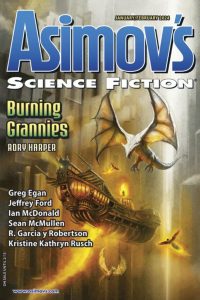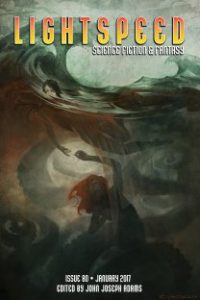Gary K. Wolfe Reviews The Visual History of Science Fiction Fandom, Volume One: The 1930s by David Ritter & Daniel Ritter
 The Visual History of Science Fiction Fandom, Volume One: The 1930s, David Ritter & Daniel Ritter (First Fandom Experience 978-1-7332964-4-1, $150.00, 516pp, hc) February 2020.
The Visual History of Science Fiction Fandom, Volume One: The 1930s, David Ritter & Daniel Ritter (First Fandom Experience 978-1-7332964-4-1, $150.00, 516pp, hc) February 2020.
Fandom may be a billion-dollar industry these days, and the field of fandom studies has drawn enough scholarly attention that it even has its own academic journal, so old-time SF fans might be excused a degree of smugness while claiming – not unreasonably – that the whole modern phenomenon began in the pages of 1930s pulp SF magazines. Except for the sometimes self-serving personal accounts in fan histories like Sam Moskowitz’s hyperbolically titled The Immortal Storm (1951) and the occasional memoirs by Pohl, Knight, Williamson, Asimov, and others, though, the only access most of us have had to the original documents of ancient fandom have been in a handful of research libraries with SF special collections. Now an enormous, glossy, five-pound, 500-page compendium called The Visual History of Science Fiction Fandom, Volume One: The 1930s sets out to remedy that with hundreds of facsimile reproductions tracing the history of fandom’s first full decade of activity, leading up to the first World Science Fiction Convention in 1939 in New York. It’s an undeniably impressive piece of work, and priced at $150 (in hardcover, from <firstfandomexperience.org>) or $39.00 in Kindle format, it may be the most thoroughly quixotic labor of love I’ve had the chance to review. A word of caution about the ebook, however: it’s a print-replica of a 9¼ x 12¼ inch book, not suitable for readers that don’t support color and probably best viewed on a pretty large screen. Many of the images are browned or fading fanzine pages, some of which require a magnifying glass to decipher even in these high-quality reproductions.
As a resource for those interested in early fan history, there’s nothing to compare with it, but I wonder if editors David & Daniel Ritter (whose website features a boatload of similar goodies) might be a tad bit optimistic about how many readers are that interested. Despite the glimpses it offers into the youthful ambitions of writers and editors like Pohl, Asimov, Bradbury, Blish, Wollheim, Campbell, and others; despite interesting trivia like the notion that cosplay may have begun when Forrest Ackerman and Myrtle Douglas showed up at that first Worldcon dressed as characters from Things to Come; despite the abundant evidence that ego-fueled flame wars long predate the Internet (the flames just took longer to arrive); the fact remains that this not-quite-epic origin story mostly concerns a few dozen young fans and a handful of professional writers, mostly in the eastern US and overwhelmingly male and white. While some of the debates they initiated helped frame questions that would persist for decades to come – such as whether SF should be socially activist, as Pohl and Wollheim argued, or more purely concerned with science, as Moskowitz and others maintained – others read like schoolyard snark.
Ritter & Ritter’s own narrative, which stitches the whole thing together, is reasonable and clearly written, and recognizes that some of the attitudes of the 1930s age pretty badly (they even quote Jeannette Ng). So here’s John W. Campbell meeting the later-to-be-legendary editor Julius Schwartz (“somewhat Hebraic to put it mildly”) and a 19-year-old Asimov getting into a letter feud with a female fan by writing, “Let me point out that women never affected the world directly. They always grabbed hold of some poor, innocent man, worked their insidious wiles on him… and then affected history through him.” (I doubt I’d want to own up to all the stuff I said when I was 19, but I’m pretty sure it wasn’t that.) The editors, for their part, do make an effort to recognize female fans of the period, such as that cosplaying Myrtle Douglas (AKA “Morojo”), or Doris Baumgardt, who wrote as Leslie Perri and eventually married Pohl, and they even include a proposal for an “all-girl” fanzine called The Feminine Fan, although they couldn’t find evidence it ever actually happened. They also devote some attention to British fandom and even a bit on Australia and New Zealand (which apparently produced the first fanzine outside North America). Overall, it’s a fascinating, dusty attic of a book, a trove for researchers, and an entertaining reminder of the hapless ur-geek culture that eventually gave rise to that billion-dollar industry.
Gary K. Wolfe is Emeritus Professor of Humanities at Roosevelt University and a reviewer for Locus magazine since 1991. His reviews have been collected in Soundings (BSFA Award 2006; Hugo nominee), Bearings (Hugo nominee 2011), and Sightings (2011), and his Evaporating Genres: Essays on Fantastic Literature (Wesleyan) received the Locus Award in 2012. Earlier books include The Known and the Unknown: The Iconography of Science Fiction (Eaton Award, 1981), Harlan Ellison: The Edge of Forever (with Ellen Weil, 2002), and David Lindsay (1982). For the Library of America, he edited American Science Fiction: Nine Classic Novels of the 1950s in 2012, with a similar set for the 1960s forthcoming. He has received the Pilgrim Award from the Science Fiction Research Association, the Distinguished Scholarship Award from the International Association for the Fantastic in the Arts, and a Special World Fantasy Award for criticism. His 24-lecture series How Great Science Fiction Works appeared from The Great Courses in 2016. He has received six Hugo nominations, two for his reviews collections and four for The Coode Street Podcast, which he has co-hosted with Jonathan Strahan for more than 300 episodes. He lives in Chicago.
This review and more like it in the May 2020 issue of Locus.
 While you are here, please take a moment to support Locus with a one-time or recurring donation. We rely on reader donations to keep the magazine and site going, and would like to keep the site paywall free, but WE NEED YOUR FINANCIAL SUPPORT to continue quality coverage of the science fiction and fantasy field.
While you are here, please take a moment to support Locus with a one-time or recurring donation. We rely on reader donations to keep the magazine and site going, and would like to keep the site paywall free, but WE NEED YOUR FINANCIAL SUPPORT to continue quality coverage of the science fiction and fantasy field.






